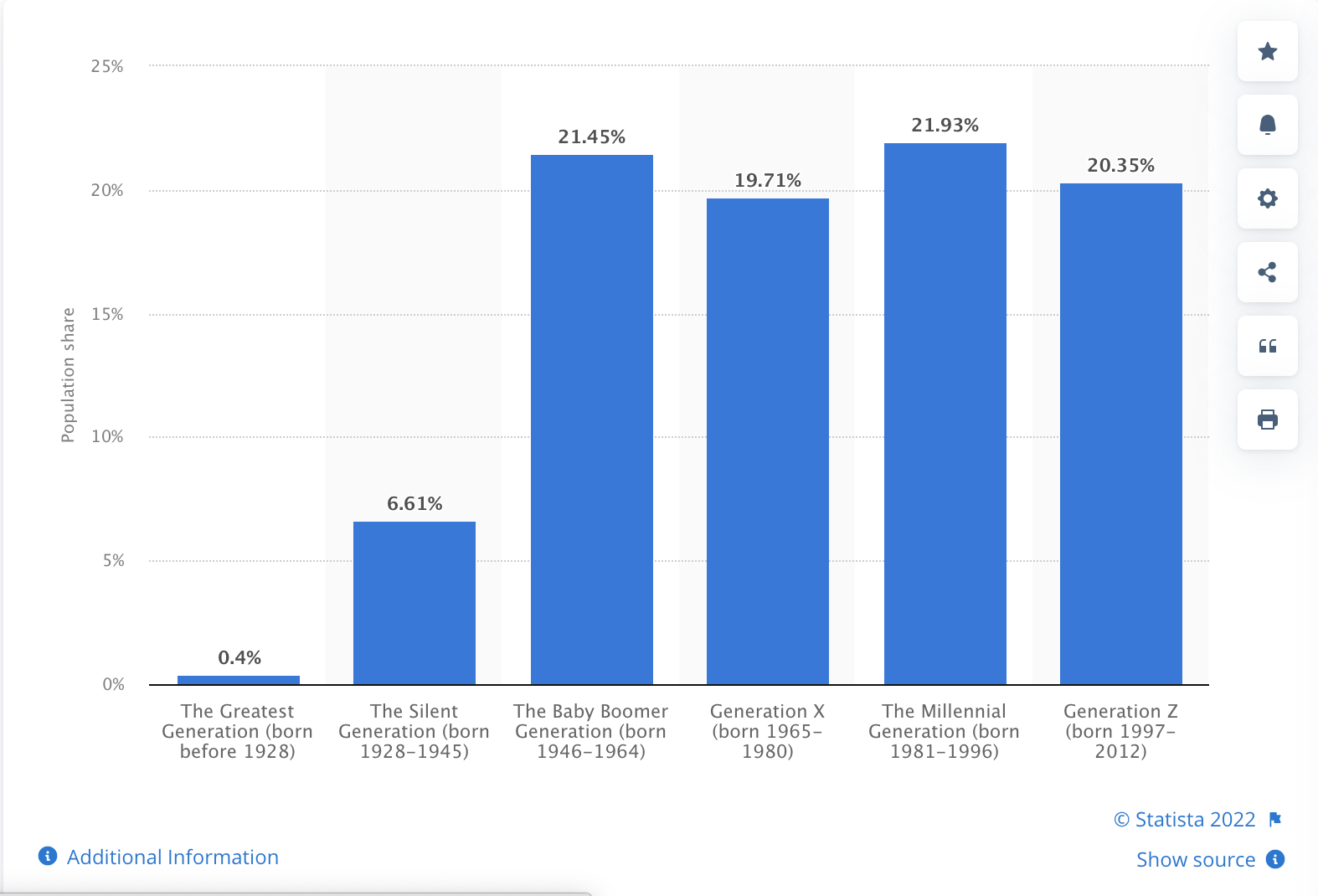 Every generation searching, clicking, and purchasing online has its preferences—and not just when it comes to what they are buying.
Every generation searching, clicking, and purchasing online has its preferences—and not just when it comes to what they are buying.
Why and how they decide to make those ecommerce purchases also varies.
This means that when you target a specific demographic, understanding their mindset and actions is extraordinarily valuable for building your strategy.
So, we wanted to kick open the doors and uncover the data for the primary four generations of ecommerce customers: Baby Boomers, Gen X, Millennials, and Gen Z. No generational jokes or judgments—just the data. Let’s dive in.
 Baby Boomers
Baby Boomers
The Baby Boomer generation is generally defined as being born between 1946 and 1964, and as of 2022, range in age from 57 to 75. It was estimated that in 2020 about 21% of the US population were Baby Boomers. So how does this generation interact online?
Baby Boomer Ecommerce Share
If we consider the slice of the pie this generation holds for ecommerce purchasing, Baby Boomers command just under 30% of online purchasing. We also include everyone in the “above 65” category in this number to keep things simple. But all in all, 30% is not too shabby—and should not be overlooked.
Baby Boomer Buying Power
Many ecommerce brands are often chasing those discretionary spending dollars, and Baby Boomers have the cash. Around 70% of disposable income in the US is held by Baby Boomers, and they spend over half a trillion dollars annually.
But wait, there’s more! Well, not more cash, but more good news. We said that they command about 30% of ecommerce activity, but over 60% of Baby Boomers are active ecommerce shoppers. This means an estimated $340 billion in discretionary spending to digital storefronts every year from Baby Boomers alone.

Baby Boomer Ecommerce Trends
Still in doubt that this generation is worth targeting online? Didn’t think so. But what Baby Boomers are purchasing online might surprise you a little.
Just because this generation holds the greatest number of retirees doesn’t mean that travel sites are going to top the ecommerce spending list. In fact, this generation’s purchasing habits are quite diverse.
While the top ecommerce purchase categories include cosmetics, appliances, healthcare products, skincare, wine, books, and household goods, there are additional ecommerce habits worth noting. For example, more than 40% use digital coupons in-store, 14% grocery shop online, and 50% prefer to shop online during the holiday season.
 Generation X
Generation X
For some reason, Generation X seems to be left out of many discussions within the ecommerce landscape, which is a big mistake. Gen X is generally defined as the generation born between 1965 and 1979 and sometimes 1980. They range in age from 42 to 57 as of 2022 and account for just over 19% of the US population.
Gen X Ecommerce Share
Now, while Gen X does not hold as much of the ecommerce purchase activity as Baby Boomers (15.5% vs. just under 30%), remember that Gen X is accounting for a 15-year age range, while Baby Boomers include pretty much anyone over the age of 57. That being said, let’s check out the data.
Gen X Buying Power
Gen X accounts for about a fifth of the US population and generates over 30% of all income in the country. This equates to roughly $2.4 trillion in buying power.
Yes, that is trillions with a “T”. Now, disposable income numbers get a little muddy as an overall metric; however, according to Statista, this generation’s average disposable household income is just under $115k as of 2020.
Digging deeper, we find that nearly 80% of Gen Xers make ecommerce purchases, so all of this data shakes out to an estimated $1.9 trillion in possible digital spending.

Gen X Ecommerce Trends
According to the data, Gen X seems to be less impulsive and more considerate than other generations. For example, while 70% of Gen Xers are very brand loyal, but – more than 85% stated they would consider a different brand if offered a discount.
Additionally, just over 45% have used the “buy now, pay later” options that many websites now provide. So, while this generation’s ecommerce buying may fall on the more conservative side (comparatively), the purchasing power is there.
 Millennials (Gen Y)
Millennials (Gen Y)
Now we reach the generation that has probably been on the lips and minds of more ecommerce brands than we can count. This generation is typically noted as being born between 1980 and 1996 and has an age range of 26 and 41 as of 2022.
Beyond this, Millennials currently make up about 22% of the US population. This is on par with Gen X, likely due to the relative 15 years that each generation has between the beginning and ending birth years.
Millennial Ecommerce Share
What this generation lacks in population volume (compared to Baby Boomers), they make up for it in their use of ecommerce across the board. In fact, Millennials make just over 37% of ecommerce purchases in the US, far outweighing the online purchasing activity of Baby Boomers, Gen X and Gen Z.
One reason for this could be that Millennials entered the world on the cusp of the technological revolution between the analog and digital worlds. Meaning that they have adapted to and adopted more technological advances (like ecommerce) than perhaps any other generational group.
Millennial Buying Power
Currently, Millennials find themselves also between two worlds when it comes to purchasing power due to rapid economic changes.
An example is that only 17% of Millennials are homeowners, and 42% of Millennials had purchased their first home by age 30 compared to Gen X at 48%, and Baby Boomers at 51%.
That being said, Millennials hold $1.4 trillion in purchasing power and 82% engage in ecommerce purchasing. This breaks down to about $1.1 trillion in digital purchasing power.

Millennial Ecommerce Trends
If you were trying to pin the shift from retail to ecommerce purchasing on a single generation, it might, in fact, be Millennials. Why? Nobody researches their purchases like Millennials! Data shows that 53% of Millennials would rather do their own online research than speak to someone over the phone.
But there is more.
Forty-five percent of Millennials price compare, and 80% read those reviews your customers leave online. Looking at Amazon, just under 50% click that buy-now button at least once a week, and 60% prefer generic brands over big-name brands.
This may be one of the reasons that emerging brands like to target Millennials—they are willing to try a competing product (or brand) at a pretty decent rate.
 Generation Z
Generation Z
Finally, we reach the youngest of the generations on this list: Generation Z. Many eyes are on this generation, being that they are the first generation born into a fully connected, internet-driven world.
Gen Zers were born between 1997-2012, range in age from 10 to 25, and make up about 20% of the US population. This may come as a surprise for many that simply consider Gen Zers teens and tweens.
Gen Z Ecommerce Share
It will probably come as no surprise what share of the ecommerce market this generation holds, being that they are the youngest on this list. Clocking in at just over 18% of online purchasing activity, this number is actually excluding influential purchase activity that is acted upon by their (likely) Gen X parents.
As Gen Z was born into the internet age, it will be interesting to see how this market share shifts over the next 5-10 years.
Gen Z Buying Power
We know there will be a gap in purchase power for Gen Z, being that the majority are under legal working age.
Even with this in mind, Gen Z still holds almost $150 billion in buying power on their own and turns to ecommerce purchasing more than any other group (about 88% of the time).
This number alone breaks down to about $130 billion in digital purchasing power, which is nothing to sneer at. Again, this omits how this generation may be influencing the purchasing behaviors of their parental figures or households in general.

Gen Z Ecommerce Trends
Now, the million-dollar question: How does this generation think? Which always seems to be the question posed by preceding generations. Let’s look at the data.
First off, this generation uses social platforms like no other when it comes to researching what they are thinking about buying. Nearly half (47%) do their research on (in rank order) YouTube, Instagram, TikTok, and Snapchat.
Top purchase categories include electronics and technology, health and wellness, education, discounted promoted products and services, and small businesses.
This is where it gets interesting. A reported 62% noted that affordability was a main concern for their purchases, which is 9% higher than 52% reported across all generations.
Yep, even Gen Z likes getting a good deal.
On the other side of the coin, across generations 71% focus on quality when making purchases, while this only applied to 64% of Gen Z. Still a major factor for sure, but for Gen Z price seems to trump quality.
All Generations Are Turning to Ecommerce
With ecommerce purchasing nearly accounting for 15% of total retail purchases, there is a lot of room for growth and adoption still to come. We point this out because there is a misconception that there is no space to “get in” or take advantage of the ecommerce buying power across generations.
But there are opportunities in each sector, industry, vertical, and generation.

The preceding data metrics are being shared here to pull back the curtain and remove some of the mystery that seems to envelop the digital ecommerce space.
So, we invite you to apply this knowledge to your current campaigns and digital marketing in general. If you need a professional to take a look and see what opportunities you are missing or what you can improve, let us know.
Shoot us over your info using our contact page or you can call us directly at (818) 740-4774, and we can help you get on track in record time.